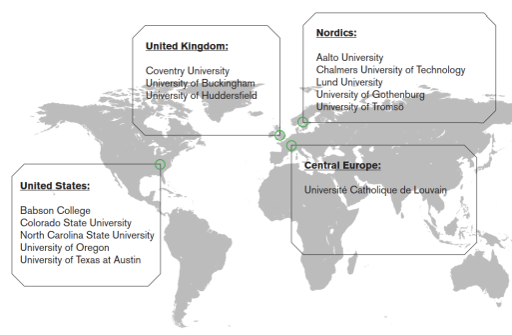Our definition of venture creation programs includes not just learning through the venture, but that the learners that are venture creating have the intention to incorporate. This emphasis aims to address the identity constrution process that occurs while enacting entrepreneurship. Learning through creating a new venture includes constructing a future self – the future identity of the entrepreneurial individual in the real venture. This helps to integrate the individual and team’s reasoning and learning around current issues and the influence, consequence and impact of decisions taken in the present. Intention to incorporate, including pre-emptive framing of collaboration agreements, customer contracts, etc. build entrepreneurial agency in the venture creation process – a factor lacking in many project-based or simluation-based educations.
A venture as a key learning vessel
Entrepreneurship is very often a journey through the unknown, sometimes even exploring the currently unknowable. Learning to act within uncertainty is challenging to simluate. VCPs (venture creation programs) use the process of creating the venture as the key learning vessel in order to emerse the learners (students) in the unknown, the uncertainty of the entrepreneurial process. Of course, to facilitate learning, students/learners are given support and guidance in various aspects of the venture creation: access to theories and practices on creating a new venture; access to faculty and practioners that can act as critical sounding boards throughout the process; a ‘semi-safe’ space that accepts failure and iteration, etc. But the main intention is that the process is ‘real’ – decisions taken have consequences, customers have demands and expectations, resources are limited.
Matching ideas with entrepreneurial people
Many full-VCPs act as match-makers between inventors and entreprenurial students. It can be a researcher working at the university who has made a discovery, but who lacks the time and interest to commercialize the invention. It can be a corporation whose R&D department has developed technology with applications that lie outside the core focus of their existing business. It can be an individual inventor who has more ideas than time, and who wants someone else to try and take an invention to the market. A full-VCP can facilitate the match-making between these stakeholders, forming ventures with both inventors and students as co-founders and shareholders of a future start-up.
Turning researchers into entrepreneurs is normally a quite bad idea
There is a common but largely flawed logic among entrepreneurial universities that researchers should be transformed into entrepreneurs. In theory, it might sound like a great idea. In practice, a successful researcher often makes a really bad entrepreneur. Scholars are trained into problematizing, scrutinizing, decomposing problems into its smallest parts, and writing about it in very complex ways that very few understand. Entrepreneurs rather need to do the opposite – opportunity orientation, trying to see what works rather than what is problematic and trying to create a whole entity that becomes valuable to common people. A better idea is then to connect really good researchers and their best ideas with really entrepreneurial young students who are willing to give untested ideas a chance. In research, entrepreneurs who take care of someone else’s baby idea are sometimes called “surrogate entrepreneurs”. Many full-VCPs are based on a surrogate entrepreneurship model.
Full-VCPs can deliver a steady stream of innovative successful start-ups
A recent study on 170 incubated ventures in Sweden conducted by professor Mats Lundqvist at Chalmers University of Technology shows just how good of an idea it is to match inventors with entrepreneurial “surrogate” students. In a comparison between 21 different Swedish incubators, those who employed this way of working significantly outperformed those who did not. The study was published in 2014 by the top ranked scholarly journal Technovation. Its title is “The Importance of Surrogate Entrepreneurship for Incubated Swedish Technology Ventures”. Check it out!
This is a venture creation program

At a venture creation program (VCP1), students are expected to start a real-life business venture as formal part of their studies. Common characteristics of these programs are that the students are expected to interact with real-life potential customers and partners, that they are expected to manage real-life resources such as money, products, sales materials and sometimes even staff. There are two different types of venture creation programs – mini-venture creation programs and full-venture creation programs.
Mini-venture creation programs (mini-VCPs)
A mini-venture is a venture that already from the start is planned to be terminated towards the end of the education program. Setting up and then liquidating the venture is done only as a means towards learning. Even if the venture would be successful on the market, it is nevertheless terminated after the program has ended. The most common mini-VCP is offered by the Junior Achievement / Young Enterprise organizations. More than 10 million students are reached by their mini-venture activities every year, delivered by around 450.000 staff in 100 countries.
Full-venture creation programs (full-VCPs)
A full-venture is a venture that is started with an intention to incorporate it if the students become successful in their attempt to start a venture. The fact that students will end up employing themselves if successful means that a full-VCP is always the last step in an educational journey. Otherwise it would be irresponsible from the part of the teacher. The most common full-venture creation programs are found on master and MBA level university education. Those students that succeed in starting a real-life venture then end up employing themselves as co-founders and CEO / COO / CTO of the new venture.
The HiTEC program, NC State University, NC USA
Since 1995, the High Technology Entrepreneurship and Commercialization Program (HiTEC) has been teaching scientists, engineers and managers how to translate science and technology into goods and services. Using the HiTEC Algorithm, a process developed from a National Science Foundation/Kenan Institute research grant, HiTEC has been building new high-tech, high growth companies while training the entrepreneurs of tomorrow.
In academia, our process and pedagogy have been benchmarked and exported to the UK, Portugal, Slovenia, South Korea, South Africa as well as Brown, Ohio State and Cal Poly universities in the U.S. In the business world, HiTEC is credited with supporting the formation of over 50% of the companies arising from North Carolina State University (NCSU).
Aims and Methods
Our goal is to develop the next generation of entrepreneurs while building the high growth companies of tomorrow. MBAs are teamed with graduate science and engineering students to build and launch – whenever possible – real high growth, technology-based ventures. Each team is provided a portfolio of available IP and has at least two outside business advisors or “Executives-in-Residence,” including serial entrepreneurs, CEOs, lawyers, accountants, and consultants.
The mapped process at the heart of the HiTEC experience is called the ‘Algorithm.’ This is the tool that separates HiTEC from other High-Tech Entrepreneurship courses. The Algorithm provides a process based framework for building viable startup companies from technological innovations. Issues that are both knowable and discerning at each phase in the development cycle are revealed and addressed in a rational manner. This detailed methodology permits the inexperienced entrepreneur to develop a compelling business case for his/her technology.
Background
In 1994, Angus Kingon, a world-class Materials Scientist from the College of Engineering, and Steve Markham, a serial entrepreneur from the Poole College of Management, won almost a million dollars in grants from the National Science Foundation and the Kenan Institute of Technology, Science and Engineering to study technology commercialization and develop tools to teach scientists and engineers how to commercialize their discoveries.
The HiTEC Program began teaching courses based on their research in 1995 to graduate students from both colleges. It was apparent from the beginning that the best way to develop the knowledge, skills and abilities needed to be successful, was to provide an intense experiential learning opportunity for the students. The resulting pedagogy offers not only a rich context to their studies, but also provides the potential to participate in a real high growth startup company.
Key Partners
HiTEC would not be possible without support from both the College of Engineering and the Poole College of Management. The intellectual property used in the course comes from the offices of technology transfer at NC State University, Eastern Carolina University, Universities of North Carolina at Charlotte and Chapel Hill. Over the years, we have also used IP from more than a dozen local R&D facilities located in the Research Triangle Park and beyond.
Finally, and perhaps most importantly, we would not be able to deliver the quality educational experience and maintain the expectations of continuing success without our Executives-in-Residence. Since 1995, more than 80 serial entrepreneurs, service providers and professionals have volunteered thousands of hours to help mentor the HiTEC teams.
Achievements
Since its inception, the TEC Program has taught over 450 graduate students, been primarily responsible for the creation of new high tech ventures and lines of business employing over 400 people, and assisted more than forty companies that have attracted over $200,000,000 in capital.
The HiTEC program is regularly benchmarked as a leader in technology commercialization education by universities around the world. Our international efforts were recognized by the Roundtable on Entrepreneurship Education at Stanford when they bestowed the 2006 Price Foundation award on us for our work in Portugal.
Key Challenges
We have three areas of ongoing challenges. First, though we have an extensive network of executives and service providers in the local entrepreneurial community, finding seasoned leaders for the new ventures we generate every year is a daunting task. Second, seed stage funding remains elusive. Finally, our department within the College of Management has undergone several changes over the past 5 years and the result has left us fewer faculty and we are therefore behind in research output.
Funding
All our activities are self-funded. We share in the royalties from one of the companies we launched. The remaining resources we have are the result of a combination of grants and gifts. The faculty have also shared consulting fees with the HiTEC program.
Chalmers School of Entrepreneurship
A two-year master program started in 1997 by two faculty members, Chalmers School of Entrepreneurship (CSE) today has four different tracks – technology, bioscience, corporate and intellectual property – accepting a total of around 50 students each year. The program has a strong venture creation track record with around 80 ventures still up and running, employing some 500 people and with a total annual turnover of €60m. A key success factor has been the establishment of a separate legal entity named Encubator, handling idea providers, equity issues and business coaching, and acting as a holding company for incorporated ventures. Key challenges have been financial sustainability and development of entrepreneurial faculty.
Aims and methods
The aim of the program is to develop entrepreneurial individuals prepared for sustainable business development in the knowledge economy. The program utilizes an action-based pedagogy where innovation and entrepreneurship is experienced hands-on and not only taught in classrooms. The education combines a distinguished academic Master’s program with real-life innovation management and venture creation of technology and bioscience innovations. The program is an integrated part of Chalmers’ strategy of being an entrepreneurial university . In 2009 an international peer review commissioned by the Swedish government gave the program the highest ranking in Sweden. Teams of two or three students are matched with a scientist or innovator to take forward a business idea into a business. At the end of the process, business ideas have the potential to be incorporated, with both students and the scientist/innovator taking ownership through shares in the newly formed business.
Background
In 1995, Mats Lundqvist and Sören Sjölander, at the department of innovation management at Chalmers, initiated development of an entrepreneurship masters program based on reflection that there was a human resource gap between university research and the marketplace. This gap could be filled by individuals willing to take viable ideas, develop business strategies and take them to the market. The program was launched in January 1997 as a one year masters-level program. In 2001, substantial developmental steps were taken, such as opening the program to students outside of Chalmers and setting up a separate legal entity called “Encubator”, gradually taking over the responsibility for many of the interactions with the outside market and society. In 2007, the program became a two year international master’s program in line with the Bologna process.
Key partners
The primary partner is Encubator, an integrated incubator that works in synergy with the program, but with a business prioritization. Encubator was created and co-founded by Chalmersinvest, a wholly owned daughter company of the Chalmers Foundation, providing seed-investment. Public actors such as Västra Götalandsregionen, Business Region Göteborg and Vinnova are key partners external to the university environment. University of Gothenburg has been an important collaborator in facilitating an interdisciplinary setting. The program also builds upon a large network of external business actors and organizations, as well as program and university alumni, to contribute content, coaching and other resources to the action-based pedagogy.
Achievements
Since its establishment in 1997, CSE has educated around 300 students. Around 50 ventures are still up and running, having been incorporated as a result of the student venture projects. These ventures have a total market value today of around €50m with an annual turnover of around €35m. The most successful ventures so far are Vehco, Avinode and Oxeon, employing around 250 people. Vehco supplies mobile IT for the transportation sector. Avinode is a global aviation broker for private jets. Oxeon is an advanced materials company. CSE has a very active alumni network where around 100 people meet every year at a conference focusing on various kinds of new value creation.
Key challenges
The main challenge has always been about financing the program. Most financial resources have been in the form of project funding, although there has been a minor endowment given to the school. Another key challenge has been to develop entrepreneurial faculty. The career paths for academics simultaneously engaging in action learning and research are challenging. A key challenge has also been the inability of traditional incentive structures and organizational leadership to adapt.
Funding
CSE receives funding for each enrolled student. However, this amount does not cover the cost of running the program and there is a need for additional funding from other sources. Additional funding has come from various sources. Funding organizations have included the public actors Västra Götalandsregionen, Business Region Göteborg and Högskoleverket. Each student ventures receives €20.000 each, majority of which requires matching with private money. This money is supplied by public venture capital entities.
Contact
Mats Lundqvist, program director
mats.lundqvist@chalmers.se
Website: www.entrepreneur.chalmers.se










